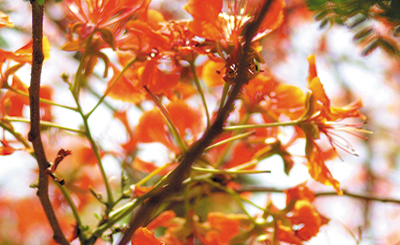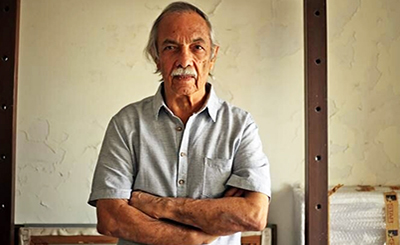
I don’t know why the big Gulmohar hasn’t shed its leaves this winter. Is it rebelling against the slothful winter or settling an old score with someone else?
The big and stately Gulmohar in our driveway hasn’t shed a leaf this winter. I hadn’t paid attention to its rebellion until I browsed through my Instagram photos. Two identical photos of the Gulmohar (one taken two years ago, and the other, three winters ago) caught my gaze and revived memories of winters bygone. In the photos, the tree is shorn of leaves, yet home to several restive crows that have taken shelter on its bare branches, waiting for the fog to disappear. Fluttering their cold wings, more crows look for room to land. A yellow moon, entangled in the Gulmohar’s branches, sees no hope of freedom. The Gulmohar is in pristine splendour, even when not abloom.
This winter, I waited for it to adorn the same bare look. December made way for January. February is dying. After months of hibernation, snails have come out to feed off the soft bark of trees. Their shells bear the first signs of spring. Next to the Gulmohar are its two companions: a Neem and the trunk of a smaller Gulmohar whose branches were chopped last summer. The management of our housing society claimed to have valid reasons for sending the tree to its afterlife. ‘The tree is diseased,’ some experts had rued. ‘It will infect other healthy trees, including the big Gulmohar, if left uncut. Look at its ulcerated bark, its worm-ridden leaves.’ The management had received the necessary permission for its felling from the concerned department of the government. The Green Tribunal had acquiesced after meticulously reviewing the ‘hopeless case’. The nod for felling the Gulmohar had been secured and its fate sealed. ‘Everything is being done in keeping with the established norms for dealing with decaying or diseased trees,’ a management committee member, presenting the paperwork before some of the protesting residents, had argued. However, sensing the anger of some tree-loving residents, the felling had been called off. Instead, after a hard-fought battle with the management, the friends-of-trees group of residents had settled for getting rid of the Gulmohar’s diseased branches, sparing its trunk and roots. Perhaps they were hopeful of its revival.
‘How did this happen?’, a little girl had asked her mother upon being told of the Gulmohar’s incurable affliction. The gardener of our housing society had betrayed no emotion while watching the woodcutters animatedly strategise how best to finish the task with least inconvenience to the residents. He had no explanation for the girl’s questions. ‘Is it necessary to use an axe?’ the girl had sobbed. ‘Can’t they softly tear off the sick branches without hurting the tree? What if it dies? Wouldn’t this be murder?’
The small Gulmohar had made a loud noise on receiving the first blow of the axe. The woodcutters had assured the residents of finishing the task to their utmost satisfaction in minutes. Little did they know the tree wasn’t going to give up easy. The woodcutters had dealt blow after blow at the branches. Every blow had taken a toll on their bodies. They had to toil harder and harder and take turns to regain their energy. Some passersby had gathered to watch the axing, as if they wanted to know if the Gulmohar would run away at the sight of the axe-wielding humans. Everyone, except the morose little girl who was swiftly whisked away by her mother, had abandoned their daily chores that Sunday afternoon and made a beeline for the driveway just to see the act. Some residents had even instructed their children not to touch the leaves lest they contract the deadly infection. Flaunting their knowledge of getting-laborious-things-done-easily, some residents had even nagged the woodcutters to follow a certain order while cutting the branches. Sensing an opportunity to brandish their usefulness and ingenuity, the security guards, with the help of a contractor, had arranged a wheelbarrow to swiftly dispose off the deadwood in a barren plot of land not far from the apartment complex.
Towards the end of the massive open-air amputation, a few bystanders had even oddly cheered, not as much for the Gulmohar’s salvation as for a job well done by the team and for not causing any major disruptions to the routine human and vehicular movements in our driveway.
The Gulmohar’s near-rebellious yet commendable cooperation with the woodcutters had gone unnoticed.
Page
Donate Now
Comments
*Comments will be moderated










